Remember the time when you could buy an absolute monster of a GPU like 1080Ti for 700$? Now, you pay more than $700 for a mid-tier class of GPU like RTX 4070Ti.
There is no denying that the performance has increased a lot over the years but so has the price. RTX 4090 goes for about $1600 which is insane if you think cards like 980Ti were priced at $650 at launch.
With all the clever marketing, companies show us the performance increase, often inflated with gimmicks like DLSS 3, to confuse us and we often forget how price increases relative to the performance.
Nvidia’s latest generation of GPU, the Ada architecture, RTX 40 Series has opened the eyes of many to how the price increase is becoming absurd each generation.
Let’s go back a few years and look at the price increase and the relative performance uplift with each generation of graphics cards and figure out if we are paying more for the relative performance increase.
Moore’s Law
According to Moore’s Law, as the number of transistors on a silicon chip typically doubles every two years, the computer’s performance and capabilities will keep rising while their costs are falling.
American engineer Gordon Moore made the forecast in 1965.
It has long been believed that Moore’s law predicts that CPU performance will double every 18 to 24 months, which is inaccurate. Moore’s law foresaw a doubling of transistor counts as opposed to raw performance increases.
Moore’s law is highly debatable but all the signs point towards Moore’s Law not being a thing anymore. The advancements in CPU and GPU space are no longer able to keep up with Gordon Moore’s predictions.
Since it is highly debatable whether Moore’s law is dead or not, we will shift our focus to the “value” aspect and generational improvement in value.
We will go back several years to figure out how well the performance and price have scaled over multiple generations.
How to read this data?
The graph shows the percentage increase in performance relative to the previous generation. It also shows the price trend and percentage increase in price relative to the previous generation.
Performance increase and price increase alone don’t show the generational value but when put together, you get a very clear idea of how performance has scaled with the price increase.
Note: The launch price is being considered for simplicity and fairness for all generations.
Nvidia Top End Class (-90 class) value over the years
| Year | Series | GPU | Price | Price Increase | Performance increase |
| 2009 | GTX 20 series | GTX 285 | $400 | – | – |
| 2010 | GT 480 series | GT 480 | $500 | 25% | 30% |
| 2011 | GTX 500 series | GTX 590 | $700 | 40% | 70% |
| 2012 | GTX 600 series | GTX 690 | $1000 | 42% | 42% |
| 2013 | GTX 700 series | GTX 780Ti | $700 | -42% | 0% |
| 2015 | GeForce 900 series | GTX 980 Ti | $650 | -7% | 28% |
| 2016 | GeForce 10 series | GTX 1080Ti | $700 | 7% | 67% |
| 2018 | RTX 20 series | RTX 2080 Ti | $1200 | 71% | 28% |
| 2020 | RTX 30 series | RTX 3090 | $1500 | 25% | 30% |
| 2022 | RTX 40 series | RTX 4090 | $1600 | 6.6% | 56% |
For example, RTX 4090 gets a $100 bump from the previous generation, RTX 3090 but also gives a 56% performance increase. A 6.6% price increase, gives you a 56% performance improvement over the previous generation which is a good positive trend.
In the case of RTX 2080Ti, it gets a $500 price bump compared to GTX 1080Ti and a 28% performance increase. All good right? No. RTX 2080Ti is a terrible card generationally because it gets only a 28% performance improvement for a 71% price increase.
That’s a negative trend with respect to generational value.
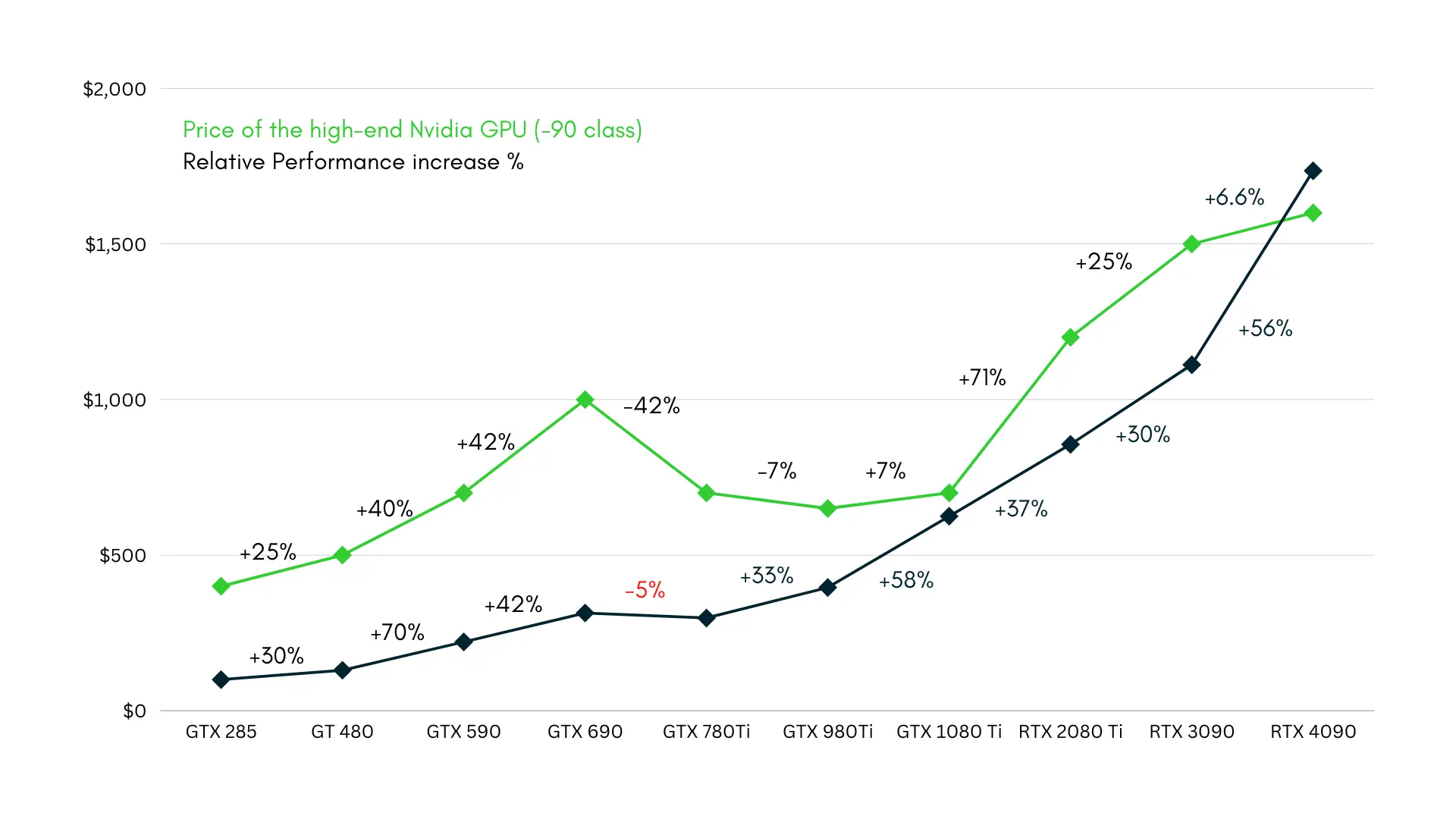
In the case of GTX 480 and RTX 3090, both get a 25% price increase compared to their previous generation but only offer a 30% performance improvement. While this is a positive trend, it is not a good one. Many would consider this a bad generational improvement.
Also read: RTX 4080 performance and review
For high-end class Nvidia GPU, the generational improvement was excellent from 2013 to 2016 which ended with GTX 1080Ti, which is still considered one of the best cards ever made.
There are also cases where there is no performance increase but the price has dropped significantly. GTX 780Ti gets a $300 price reduction compared to GTX 690 but the performance remains virtually the same.
One could argue that there is no real value in this since there is no performance increase. While some may say that there is a significant reduction in price. This depends on how you perceive it. If anything, it just shows how terrible the previous generation GTX 690 is.
Also read: Best graphics card to buy in India
Overall the high-end class of Nvidia GPUs have recorded at least a 28% performance increase each generation independent of the price increase with the only exception of GTX 780Ti.
While there has been significant performance improvement, the price has also skyrocketed. Comparing GTX 1080Ti to RTX 4090, the price has more than doubled for 215% performance improvement.
Nividia mid-range ( -70 Class) generational value
| Year | Series | GPU | Price | Price Increase | Performance increase |
| 2009 | GeForce 200 series | GTX 275 | $250 | – | – |
| 2010 | GeForce 400 series | GTX 470 | $350 | 40% | 25% |
| 2011 | GeForce 500 series | GTX 570 | $350 | 0% | 37% |
| 2012 | GeForce 600 series | GTX 670 | $400 | 14% | 29% |
| 2013 | GeForce 700 series | GTX 770 | $400 | 0% | 12% |
| 2015 | GeForce 900 series | GTX 970 | $330 | -21% | 43% |
| 2016 | GeForce 10 series | GTX 1070 | $450 | 36% | 47% |
| 2018 | RTX 20 series | RTX 2070 | $600 | 33% | 37% |
| 2020 | RTX 30 series | RTX 3070 | $500 | -20% | 50% |
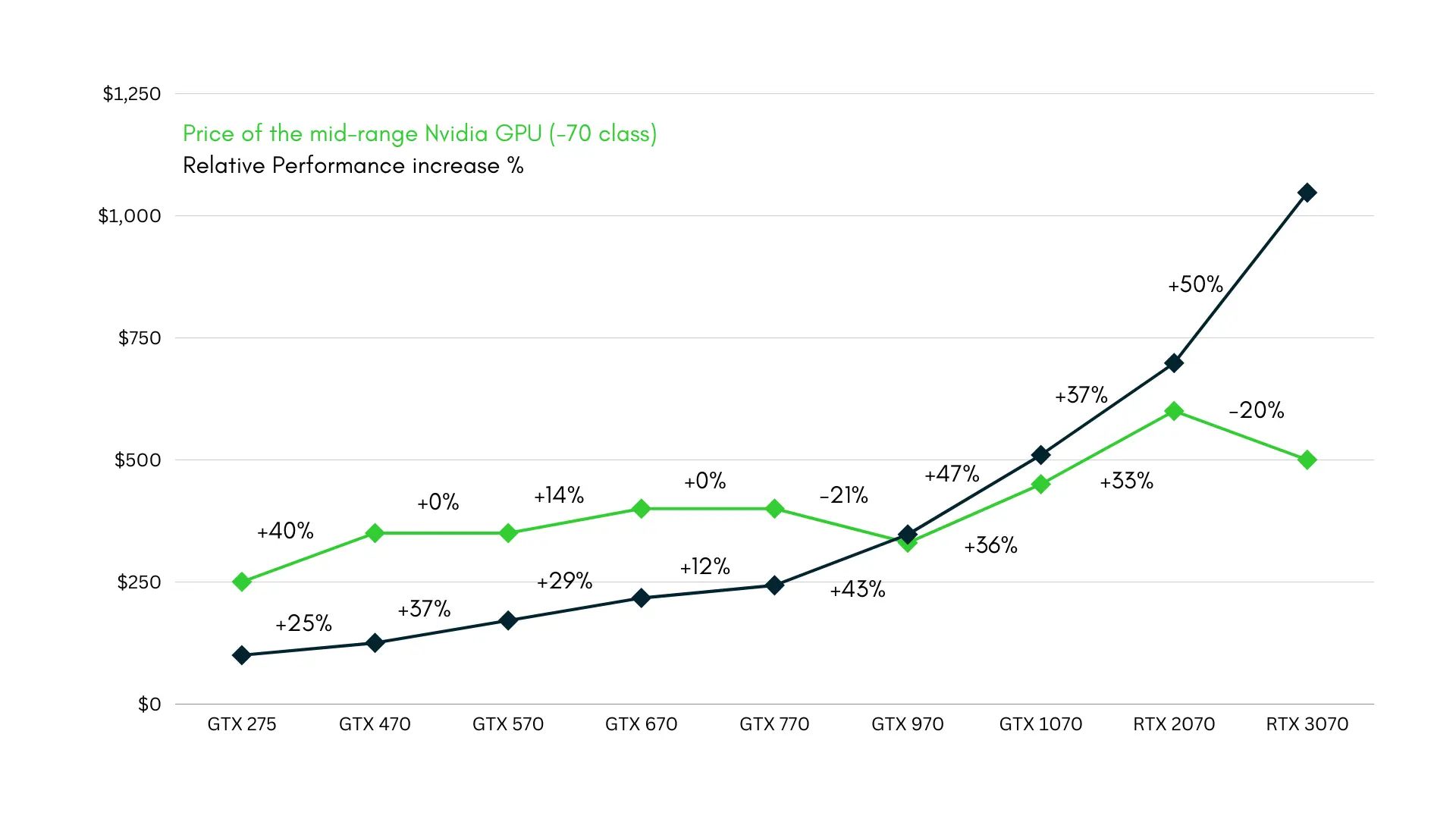
For the mid-range, Nvidia GPUs have not scaled in performance that well relative to the price increase. For example, the GTX 470 gets only a 25% performance increase for 40% more price.
RTX 3070, GTX 970 and GTX 570 are the only three cards which managed to reduce the price and increase performance significantly compared to the previous generation.
While the value aspect doesn’t go into a negative trend (GTX 470 is the only exception), it cannot be considered an encouraging trend.
For the mid-range GPUs, the trend is interesting since it provides a performance uplift with each generation similar to high-end, if not higher. Although the price increase has remained fairly stable except for RTX 20 series and GTX 400 series. Overall, the generational value increase of mid-range Nvidia GPU is only average.
Read more: Mid-Range RTX 40 graphics are not looking too hot
Nividia low-tier ( -50 Class) generational value -50 Class
| Year | Series | GPU | Price | Price Increase | Performance increase |
| 2009 | GeForce 200 series | GTX 250 | $150 | – | – |
| 2010 | GeForce 400 series | GTX 450 | $130 | -15% | 3% |
| 2011 | GeForce 500 series | GTX 550 Ti | $150 | 15% | 19% |
| 2012 | GeForce 600 series | GTX 650 | $110 | -36% | 1% |
| 2013 | GeForce 700 series | GTX 750 | $120 | 9% | 29% |
| 2015 | GeForce 900 series | GTX 950 | $160 | 33% | 59% |
| 2016 | GeForce 10 series | GTX 1050 | $110 | -45% | 6% |
| 2018 | GTX 16 series | GTX 1650 | $150 | 36% | 56% |
| 2020 | RTX 30 series | RTX 3050 | $250 | 66% | 75% |
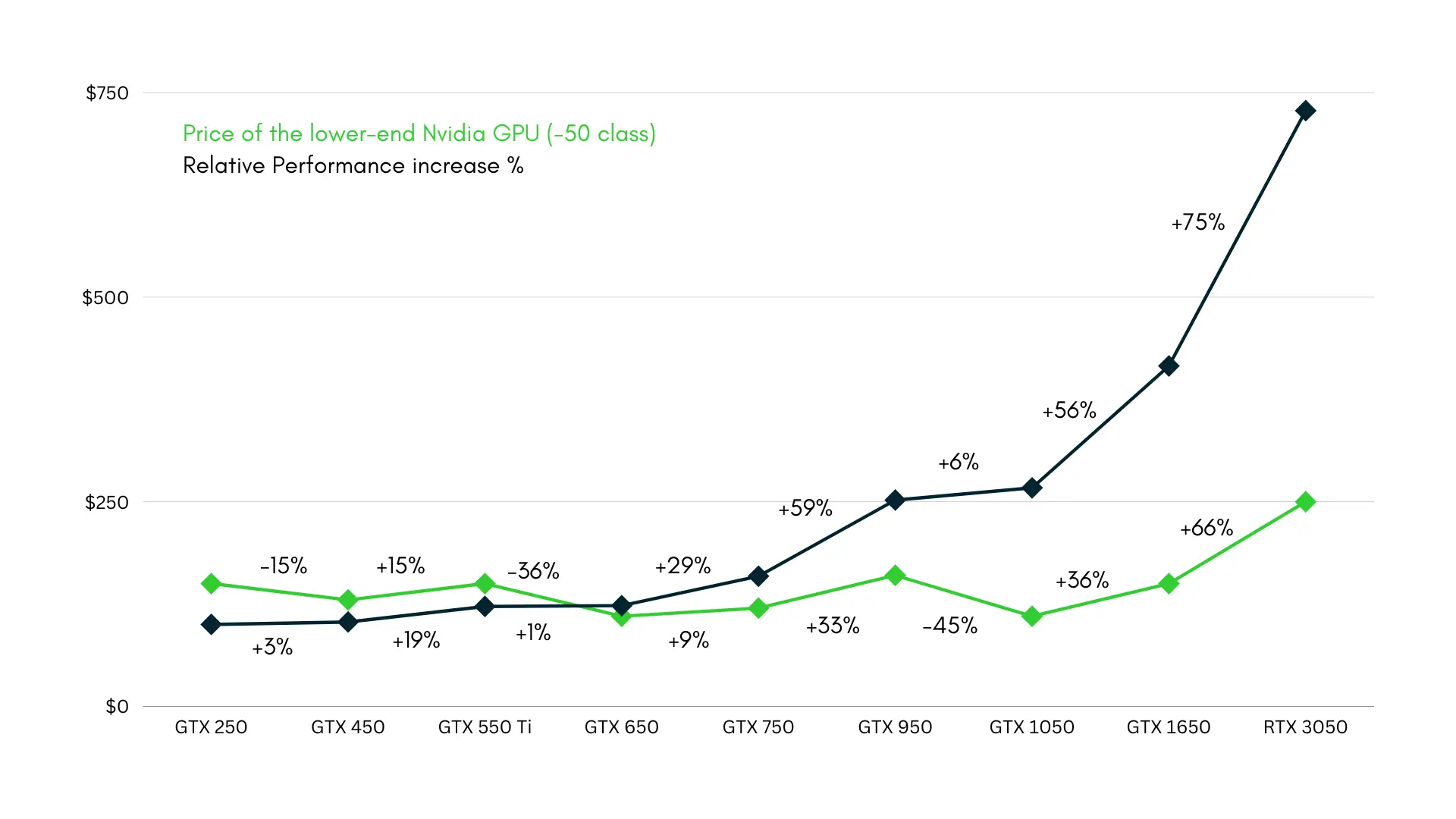
For the lower class of GPU, the price is more important than the performance uplift each generation. It becomes pointless if the price is too high to be considered a lower-tier card even if the performance is good.
The price has to stay consistent each generation even if the performance gain isn’t that high. The prices have remained stable under $150 with the only exception being the RTX 3050 which isn’t a great value card anyways and is very evident.
The trend of value increment is always positive but not always great. Overall, for the lower-end cards, Nvidia has stayed pretty consistent with the price even though the performance increase isn’t very dramatic.
GTX 1650 and GTX 950 are the only exceptions where it got more than a 50% performance increase albeit with a 33% price increase.
AMD
AMD’s High-End generational value
| Year | Series | GPU | Price | Price Increase | Performance increase |
| 2008 | Radeon HD 4000 series | Radeon HD 4890 | $250 | – | – |
| 2010 | Radeon HD 5000 series | Radeon HD 5870 | $380 | 52% | 47% |
| 2011 | Radeon HD 6000 series | Radeon HD 6970 | $370 | -2% | 19% |
| 2012 | Radeon HD 7000 series | Radeon HD 7970 | $500 | 35% | 44% |
| 2013 | Radeon 200 series | Radeon R9 290X | $550 | 10% | 50% |
| 2015 | Radeon 300 series | Radeon R9 Fury X | $650 | 18% | 31% |
| 2016 | Radeon 400 series | Radeon RX 480 | $240 | -170% | -19% |
| 2018 | Radeon 500 series | Radeon RX 590 | $280 | 17% | 15% |
| 2017 | RX Vega series | RX Vega 64 | $500 | 78% | 41% |
| 2020 | Radeon RX 5000 series | RX 5700XT | $400 | -25% | 21% |
| 2021 | Radeon RX 6000 series | RX 6900XT | $1000 | 150% | 101% |
| 2022 | Radeon RX 7000 series | RX 7900XTX | $1000 | 0% | 39% |
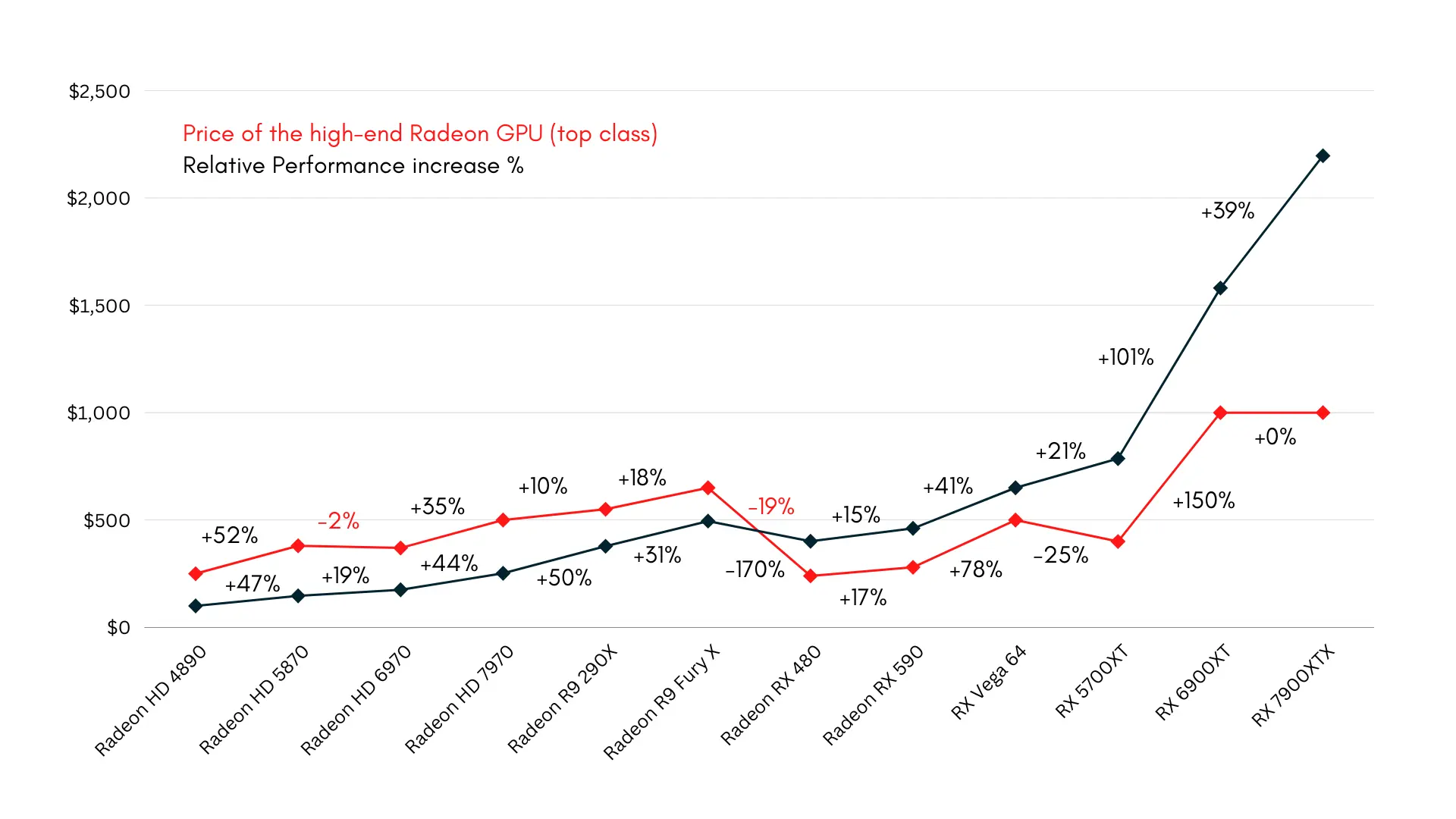
AMD’s case is curious because its high-end cards are fairly low-priced compared to Nvidia’s. But the competition here is not between Nvidia and AMD but it is about generational improvement.
For the high-end class of cards, AMD Radeon price fluctuations are all over the place but never exceed the 1000$ mark even with the latest generation. Whereas, Nvidia’s -90 class GPUs have crossed even the $1500 mark.
For some generations, the value increase is drastic while some see a dip in the value but for the most part, AMD has managed to improve the value with each generation. 2017-2018 is particularly bad with Radeon RX 590 and RX Vega 64, giving very little performance gain for the price increase.
Overall, AMD has been doing well in improving its high-end value starting with its RDNA architecture. While the latest RX 7900XTX isn’t a great value card, it is providing better value than its predecessors.
AMD’s Mid-Range Generational Value
| Year | Series | GPU | Price | Price Increase | Performance increase |
| 2008 | Radeon HD 4000 series | Radeon HD 4670 | $80 | – | – |
| 2010 | Radeon HD 5000 series | Radeon HD 5670 | $100 | 25% | 31% |
| 2011 | Radeon HD 6000 series | Radeon HD 6670 | $100 | 0% | 15% |
| 2012 | Radeon HD 7000 series | Radeon HD 7750 | $110 | 10% | 45% |
| 2013 | Radeon 200 series | Radeon R7 260X | $140 | 27% | 40% |
| 2015 | Radeon 300 series | Radeon R7 360 | $110 | -27% | -20% |
| 2016 | Radeon 400 series | Radeon RX 460 | $140 | 27% | 43% |
| 2018 | Radeon 500 series | Radeon RX 560 | $100 | -40% | 2% |
| 2019 | RX Vega Series | RX Vega 54 | $400 | 300% | 222% |
| 2020 | Radeon RX 5000 series | RX 5600XT | $280 | -42% | 8% |
| 2021 | Radeon RX 6000 series | RX 6600XT | $380 | 36% | 37% |
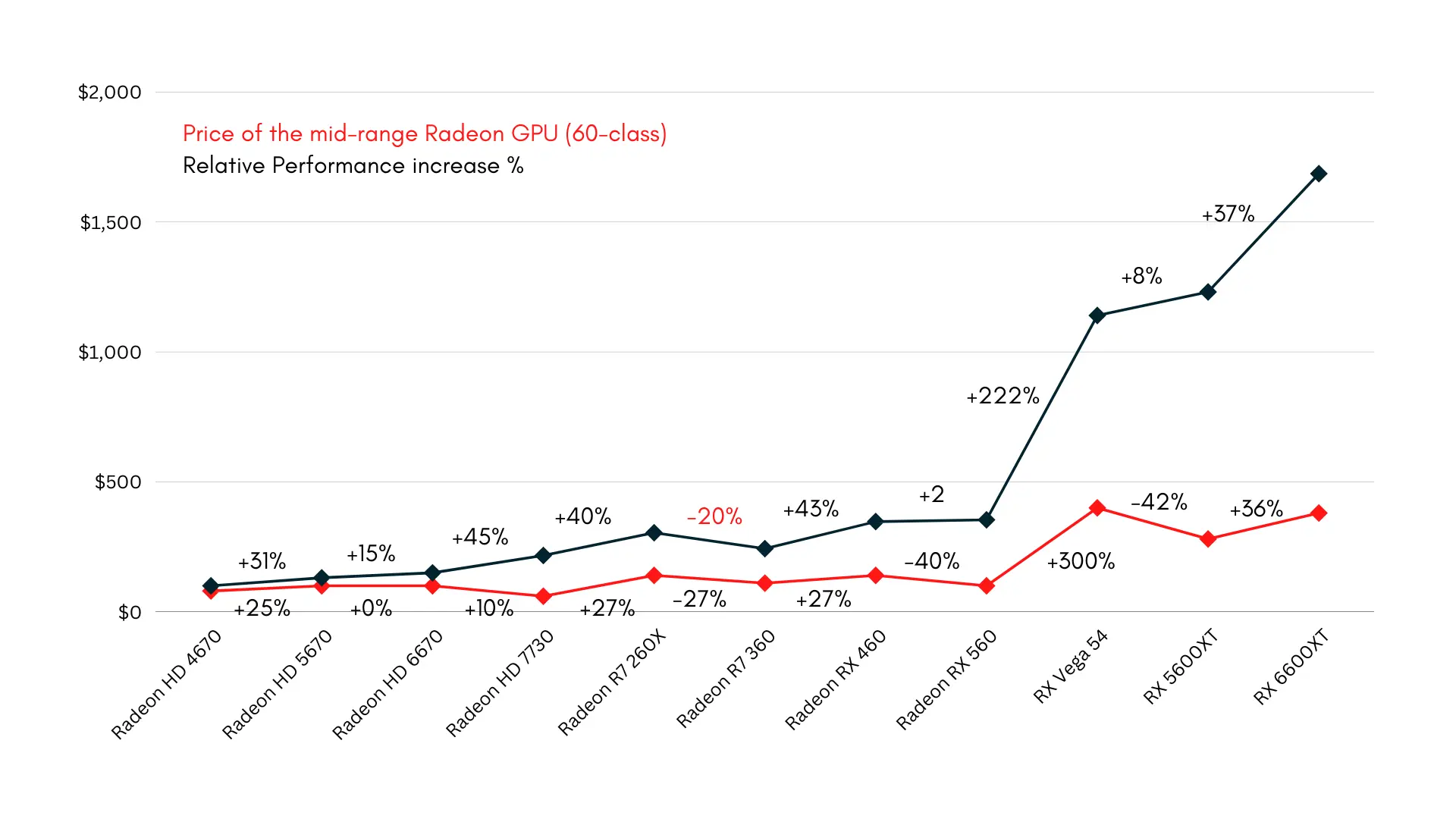
For AMD’s mid-range cards, most generational value improvement is positive but not very encouraging very similar to Nvidia’s mid-range. RX 5600XT is a great example of a mid-range card that has good generational value and is priced very well.
As you can see here, RX 6600XT doesn’t look like a very compelling card since it gives only a 37% performance increase for a 36% price increase. But we know for a fact that currently, RX 6600XT is the best value mid-range card when taken street price.
Also read: Best value budget PC build with RX 6600XT
This goes to show how launch prices affect the value of the GPUs and how the perception of value can change when the price is corrected.
It needs to be seen whether the value gets better with the RX 7000 series mid-range cards.
Is GPU value getting better or worse?
Considering the last 2 generations, there has been significant improvement in performance but the price has also skyrocketed, especially with Nvidia’s top-class GPU. There is no denying that there is no performance increase but the price has become too high even for a card like RTX 4090.
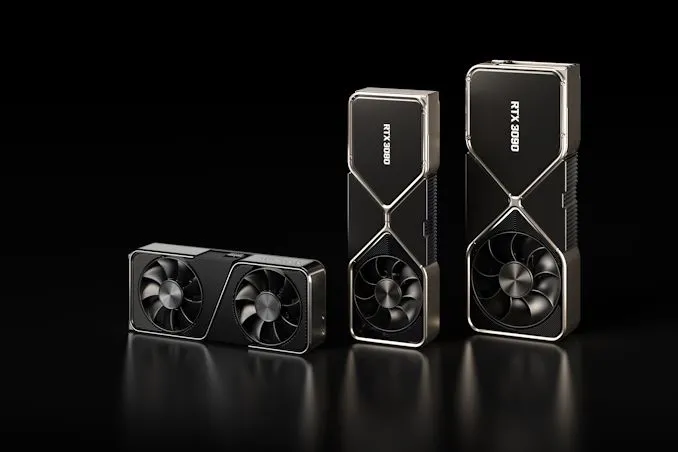
GPUs in the top and mid-tier are definitely getting better in value, especially after the end of the GTX 10 series. The trend is similar for Nvidia’s mid-range cards but the lower-tier cards do not reflect the same.
Lower-tier cards are decreasing in value as evident from the last 2 generations. It seems unlikely that the RTX 4050 will be any less than $250 given that other cards in the series have increased in price substantially compared to the last generation.
This is very similar to AMD’s case as well. AMD’s mid-range -60 and -70 class GPUs are really good in terms of value compared to their previous few generations. Although the lower-end (sub $20000 / sub-$150) range has been completely neglected by both AMD and Nvidia.
Lower-tier cards just don’t seem worth it in the last couple of generations and this is very evident since the most popular budget cards are GTX 1650 and GTX 1060 which are more than 4 years old now. These cards have no worthy replacement.
Final Thoughts
The ideal scenario would be at least a 50% increase each generation without any price increase. Or the new generation trumping its next class from the previous generation. For example, the RTX 4060 should perform better than the RTX 3070 for the same price as the RTX 3060.
GPUs are certainly getting better in value over generations, especially after Nvidia’s RT and AMD’s RDNA architecture. Intel’s first generation of Arc GPUs wasn’t great but it’s a good start and their next-generation Battlemage could certainly improve.
AMD and Nvidia are both ignoring the lower-tier GPU segment and Intel can fill that gap to gain a foothold. With three GPU makers, it will be interesting to see how the GPU market shapes up in the coming years.
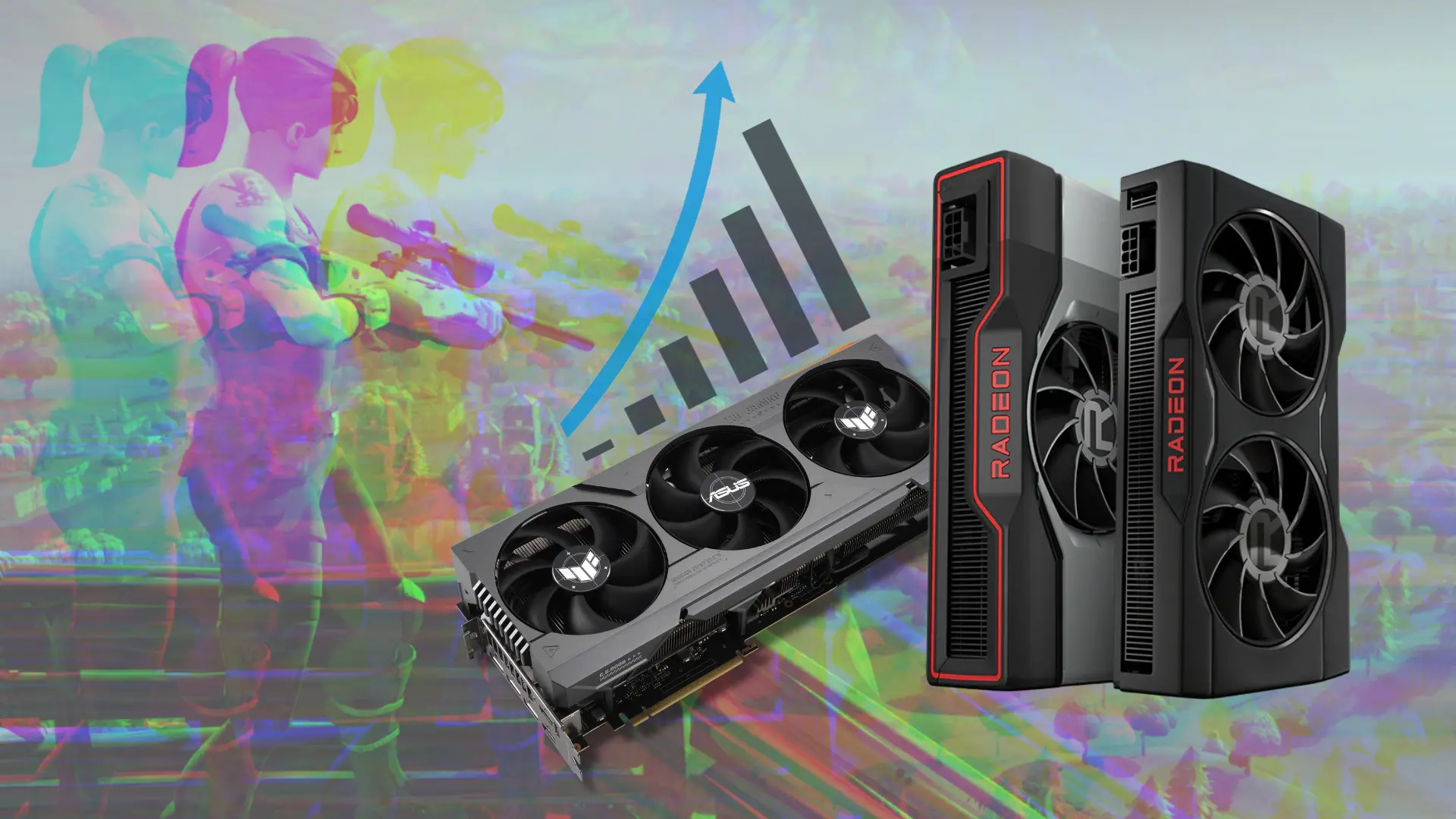
Leave a Reply
You must be logged in to post a comment.